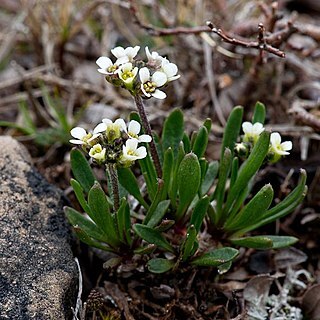Herbs perennial with simple or many-branched caudices, sometimes forming cushions. Trichomes simple or forked. Basal leaves petiolate, rosulate, simple, entire or dentate, rarely pinnately lobed, petiolar base persistent. Cauline leaves absent, rarely few, sessile or nearly so, not auriculate, entire or rarely dentate. Racemes ebracteate or only lowermost flowers bracteate, elongated or not in fruit. Fruiting pedicels erect or divaricate. Sepals ovate or oblong, caducous or persistent, erect, base of lateral pair not saccate, margin membranous. Petals white, pink, or purple, rarely yellow, longer than sepals; blade obovate or oblanceolate, apex obtuse or rounded; claw shorter than sepals. Stamens 6, tetradynamous; filaments dilated at base; anthers ovate or oblong, obtuse at apex. Nectar glands 4, 1 on each side of lateral stamen; median glands absent. Ovules 4-26 per ovary. Fruit dehiscent siliques or silicles, linear, oblong, ovoid, or lanceolate, terete or slightly latiseptate, sessile; valves with a distinct midvein, glabrous or pubescent, smooth or torulose; replum rounded; septum complete, membranous, translucent; style obsolete or to 1 mm; stigma capitate, entire or slightly 2-lobed. Seeds uniseriate or rarely biseriate, wingless, oblong or ovoid, plump; seed coat minutely reticulate, not mucilaginous when wetted; cotyledons incumbent.
Sep somewhat cucullate; pet white or suffused with purple, oblong-obovate; short stamens subtended by a U-shaped gland; filaments flat; anthers cordate-ovate; ovary cylindric, with 2–several ovules per locule; style very short; stigma capitate; fr linear, often torulose, the valves with prominent midnerve and obscure secondary nerves, the septum composed of thick-walled elongate cells and appearing transversely striolate at 20 x; herbs with simple or branched hairs. 20, circumboreal.

